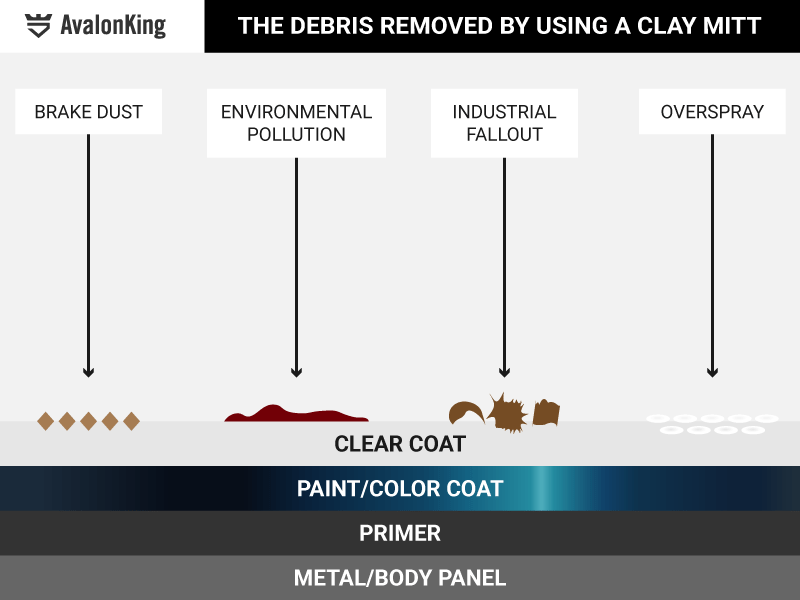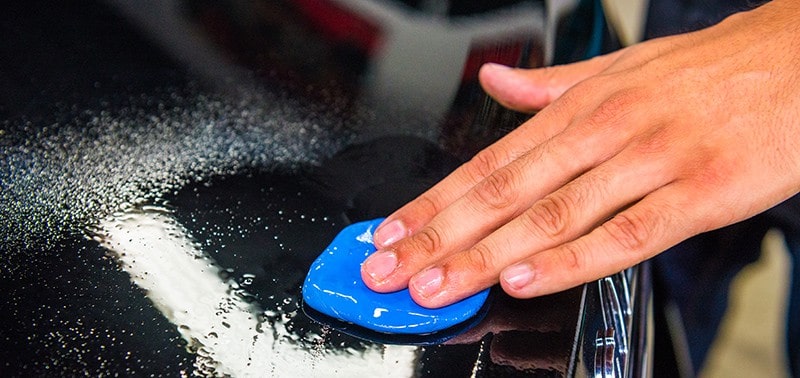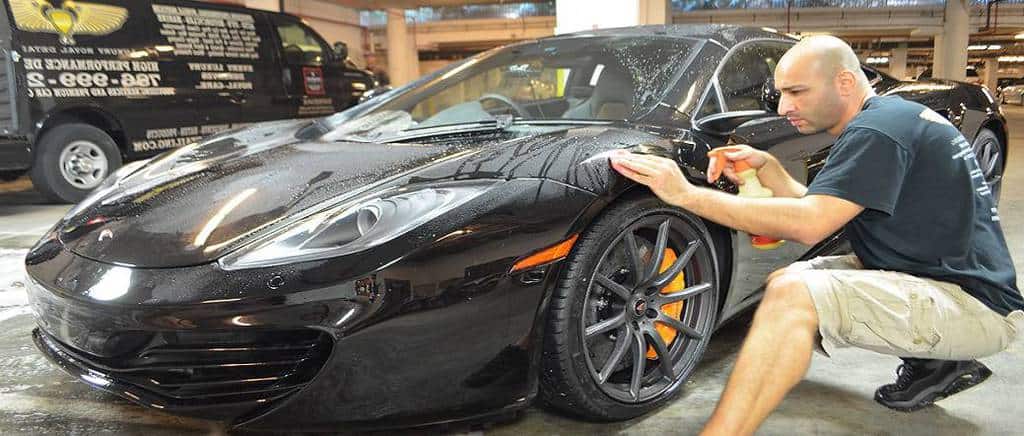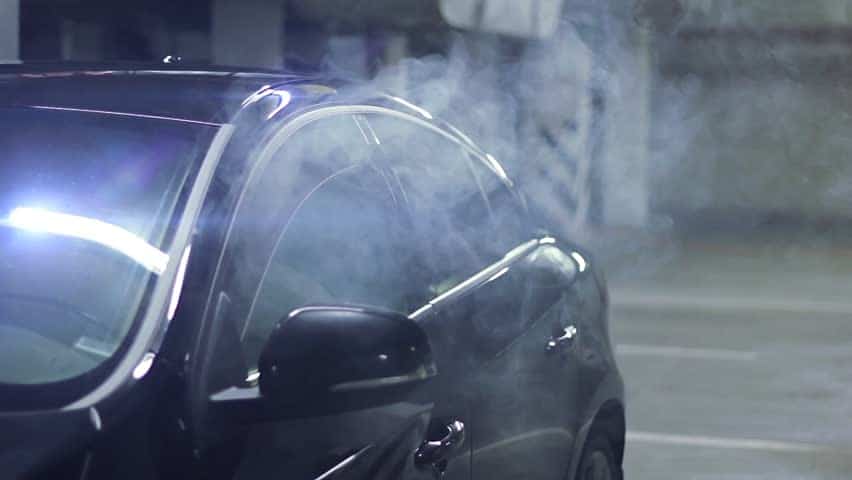One of the most important steps in a paint protection installation process is surface prep. This multiple-phase process involves removing existing waxes and sealants, older coats, and deep and embedded debris from the surface.
While there are many surface prep car shampoos on the market that can remove surface wax and sealants, getting those deep contaminants out of the clear coat of paint is a tricky task.
This is where using a surface prep mitt comes into play. Sometimes you’ll hear this type of product referred to as a clay mitt or clay bar. Regardless of the nomenclature, using some sort of surface prep medium (which is another term for washing supply) to remove deep contaminants is crucial for the correct bonding of a ceramic coating.
So, let’s dive into a few tips when it comes to choosing the best surface prep mitt for your pre-ceramic coating installation.
What is a Surface Prep Mitt?
Like we said above, a surface prep mitt is a medium or a material that is used to remove stuck contaminants like industrial fallout, brake dust, high-spots of older wax and more. Most people call this a clay mitt, which slides on your hand like a glove, making it easier to use.
For purposes of this article, surface prep mitt will be defined as the product you use to accomplish this task. It can include the following:
Clay Bar: The clay bar is a soft ‘lump’ of clay that fits in the palm of your hand. It’s a specially formulated clay that grabs substances that are stuck inside or on top of the clear coat of paint. You’ll use the clay bar in conjunction with a spray on lubrication product, to glide over the top. This reduces the potential of scratching or damaging the clear coat.
Clay Mitt: The clay mitt is a glove, that you’ll slide over your hand to accomplish the same task. The top of the mitt is microfiber, but it’s not meant to be wiped on the surface. The bottom of the mitt is embedded with clay materials. There are different grades of clay mitts, which we’ll explain below.
How Does a Surface Prep Mitt Work?
The goal of a surface prep mitt is to remove surface contaminants to prep it for a paint protection application. Some detailers recommend doing this every time you remove wax or a sealant and are ready to apply another coating.
The prep mitt or clay mitt is made from a synthetic clay, that is very tacky. When it is rubbed on a vehicle paint surface, glass, or plastic trims, it literally grabs the deep, embedded debris and pulls it off the surface.

However, there is a catch. The clay material is so good at accomplishing this, that it requires ample lubrication to do the task without scratching or damaging the surface. For those of you who are drag racing fans, think of the way that a Top Fuel dragster can apply 11,000 horsepower to the ground. It will slip the clutch but allow the tires to slightly spin and it gains momentum.
The same thing applies with surface or clay mitt lubricant sprays. It allows the mitt to slide over the surface, without really ‘grabbing’ too hard. The result is a progressive removal of debris, without causing damage. If you don’t use enough lubricant spray, the potential of damage to the clear coat, marring, or even pulling up some paint is realistic.
What are the Best Uses for a Surface Prep Mitt?
I wouldn’t go as far as saying that a surface prep mitt is a one-time use, but for purposes of applying ceramic coatings, it pretty much is. The only time you’ll use it is in the second step of prep work. It’s completed after washing the vehicle with a wax-stripping shampoo or iron fallout remover.
The clay mitt or clay bar should be used as a secondary step in removing contaminants – not as the first step. Professional detailers agree that the first step in prepping a car for wax, sealants, or ceramic coatings should be using a detergent or pH positive car shampoo. It’s basically the same type of soap used for washing dishes, but not as harsh on automotive surfaces.
This type of shampoo or prep shampoo as we call it, removes the top layer of old wax and sealants, caked on bug splatters and some other damage. The clay mitt basically cleans up what’s underneath those substances.
You can use a surface prep mitt on the following materials:
- Paint clear coats
- Automotive Glass
- Plastic Trim
- Chrome or alloy wheels
However, it’s not recommended to use a surface prep mitt on carbon fiber, fiberglass, or other softer materials. You don’t want to use it on vinyl or paint protection film.
What are the Different Types of Surface Prep Materials?
So, let’s explore the different type of surface prep materials you can use during the ‘clay bar’ step in prepping for a ceramic coating.
Clay Bar Kit

The first and easiest to use is a clay bar kit. It’s basically an all-in-one solution that include the clay and the surface prep lubrication spray. Clay bars are usually the same material – so picking one is easier than the clay mitt – where there are multiple grades.
Mild Grade Clay Mitt
There are three types of clay mitts, the mild, mid and hybrid grade. Each has their own design, and level of debris removal. Let’s start with the mild grade.

This is your entry level surface prep mitt. The clay material is designed to remove light contaminants, is easier to use, and less likely to cause marring and damage to the surface. Most of these mitts have smaller dots on the bottom layer, which makes it easier to glide over the clear coat of paint.
Mid-Grade Clay Mitt
The mid-grade clay mitt is a flat surface, where the entire bottom layer is smooth, allowing a complete surface grab. The material tends to be stickier than the mild-grade, and the design permits a smoother application.

This type of clay mitt is best used on vehicles that are older and will require paint correction – as it’s more likely to cause light scratching – especially if you’re not using enough lubricant spray.
Hybrid Clay Mitt
This is the Cadillac of surface prep mitts. The clay material is similar with the mid-grade substance, but the design of a helix or cross-hatch pattern makes it easier to glide over different materials. It’s essentially the middle ground of surface prep mitts – where it can be used on newer cars that have ceramic coating sprays or paint sealants applied.

The downside of this type of mitt is the potential of clear coat damage on vehicle without paint protection materials applied. It should only be used on cars, trucks, SUVs with existing coatings that need to be removed prior to applying a new coating.
How to Use a Surface Prep Mitt
If you’re going to use a surface prep mitt prior to applying a ceramic coating, there is a good way to reduce damage.
Step 1 – Wash and Dry your Vehicle
Before using a surface prep mitt, you need to wash your car with a wax stripping car shampoo. We recommend our own formulation, which is great for stripping old layers of wax and paint sealants. Make sure to fully rinse and dry the vehicle before proceeding with the surface prep mitt.
Step 2 – Gather Your Supplies
Based on the information above, you can determine which type of surface prep method is best for your situation. Just make sure you gather all the supplies needed for that type of product. Also, use plenty of lubrication spray.
Step 3 – Pick a Starting Point
Always work in a circular pattern when using any surface prep mitt. Its best to work in small sections, like 4×4 foot to ensure even coverage. I like to work front to back, and left to right, spraying lubricant spray with each glide of the surface prep mitt.
Clay bar treatment is best completed in small sections at a time – generally, no bigger than 2-feet x 2-feet at a time. It’s a good idea to start with the left front of the vehicle, and complete sections in a circular pattern, until you come back to the original starting point.
Once the surface area is properly lubricated, you’ll begin to gently glide the clay bar or clay mitt back and forth on the surface. When you’re completing this, you’ll feel the clay bar or mitt begin to grab at the paint surface.
Don’t worry about it – this is natural. Move the clay bar or mitt in a forward and back motion, until the grip level reduces. Continue to apply lubricant if needed until the entire section has been completed.
Step 4 – Check Your Work
The best way to determine if you’re done with a section is to use a clean, plastic sandwich bag. We mentioned this check above, where you’ll use the plastic bag as an amplifier to indicate if the surface area is clean and free of debris. The important thing to remember is to always check your work and complete each section fully before moving to the next section.
Step 5 – Rinse the Vehicle with Clean Water and Dry
Once you’ve completed the entire clay bar or clay mitt treatment, finish the job correctly by spraying fresh water over the entire car. This will remove any soap residue or loose particles from the clay treatment. When you’re done, use multiple microfiber towels to fully dry the vehicle.
Wrapping it Up
Like any other automotive paint care project, the key to using a surface prep mitt correctly is taking time. Don’t rush it to try to get everything done in an hour – or you’ll likely experience problems.
The last thing you want to have happen is damaging your clear coat, which can happen easily if you don’t use enough lubricant spray during the process.













2 comments
Dale Pearl
Hi Dave!
Good point! Most used their car shampoo in concentrate or mixed double strength. Dawn Dish soap makes a good lube for claying as well. Many clay bar and clay mitts can be purchased with a lube as part of a kit.
Hi Dave!
Good point! Most used their car shampoo in concentrate or mixed double strength. Dawn Dish soap makes a good lube for claying as well. Many clay bar and clay mitts can be purchased with a lube as part of a kit.
Dave
No mention is made of type of spray lubricant. WD-40?, WTF?, I have no clue.
No mention is made of type of spray lubricant. WD-40?, WTF?, I have no clue.